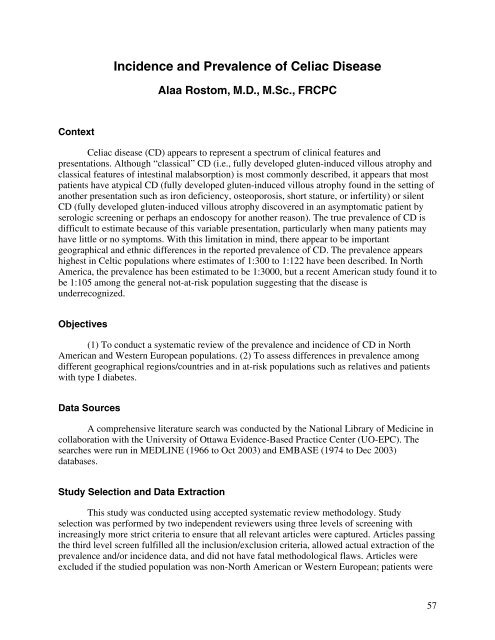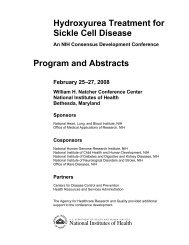Incidence and Prevalence of <strong>Celiac</strong> <strong>Disease</strong> Alaa Rostom, M.D., M.Sc., FRCPC Context<strong>Celiac</strong> disease (CD) appears to represent a spectrum of clinical features andpresentations. Although “classical” CD (i.e., fully developed gluten-induced villous atrophy andclassical features of intestinal malabsorption) is most commonly described, it appears that mostpatients have atypical CD (fully developed gluten-induced villous atrophy found in the setting ofanother presentation such as iron deficiency, osteoporosis, short stature, or infertility) or silentCD (fully developed gluten-induced villous atrophy discovered in an asymptomatic patient byserologic screening or perhaps an endoscopy for another reason). The true prevalence of CD isdifficult to estimate because of this variable presentation, particularly when many patients mayhave little or no symptoms. With this limitation in mind, there appear to be importantgeographical and ethnic differences in the reported prevalence of CD. The prevalence appearshighest in Celtic populations where estimates of 1:300 to 1:122 have been described. In NorthAmerica, the prevalence has been estimated to be 1:3000, but a recent American study found it tobe 1:105 among the general not-at-risk population suggesting that the disease isunderrecognized.Objectives(1) To conduct a systematic review of the prevalence and incidence of CD in NorthAmerican and Western European populations. (2) To assess differences in prevalence amongdifferent geographical regions/countries and in at-risk populations such as relatives and patientswith type I diabetes.Data SourcesA comprehensive literature search was conducted by the <strong>National</strong> Library of Medicine incollaboration with the University of Ottawa Evidence-Based Practice Center (UO-EPC). Thesearches were run in MEDLINE (1966 to Oct 2003) and EMBASE (1974 to Dec 2003)databases.Study Selection and Data ExtractionThis study was conducted using accepted systematic review methodology. Studyselection was performed by two independent reviewers using three levels of screening withincreasingly more strict criteria to ensure that all relevant articles were captured. Articles passingthe third level screen fulfilled all the inclusion/exclusion criteria, allowed actual extraction of theprevalence and/or incidence data, and did not have fatal methodological flaws. Articles wereexcluded if the studied population was non-North American or Western European; patients were57
identified by surveys or through solicitation of celiac societies; or reported incidence without apopulation density denominator. Study data was abstracted using a predetermined electronicform by one reviewer, and verified by another. The quality of reporting of the included studieswas assessed.Data SynthesisThe prevalence and incidence data were anticipated to be quite heterogeneousconsidering the different, countries, age groups, and risk characteristics of the studied patients.Attempts were made to group studies by age group, study population, and serological screeningmethod. If the grouped studies did not show evidence of heterogeneity, pooled estimates of theprevalence were produced for that group of studies; otherwise a descriptive presentation of thedata with a qualitative systematic review was conducted. For pooled estimates, statisticalheterogeneity was assessed along with 95 percent confidence intervals.Results and ConclusionsThe literature search yielded 2,116 references. Of these, 119 articles, were included in thereview. Of these studies, 42 assessed the prevalence and/or incidence of CD in a generalpopulation. Twelve of the 42 reported on the incidence of CD, and 30 reported on theprevalence. Studies of the prevalence of CD in populations at risk were divided as follows: 18studies of the first-degree relatives of CD patients and 34 studies in patients with type 1 diabetes.Studies of the prevalence of CD in patients with associated clinical presentations were divided asfollows: 12 studies in iron-deficiency anemia, 4 studies in metabolic bone disease, and 13 studiesof patients with suspected CD. Several studies included data for multiple at risk groups.IncidenceThe crude incidence of CD among western European and North American countries overthe past 25 years has varied between 1 and 51 per 100,000, and the cumulative incidence by age5 between 0.118 and 9 per 1,000 live births. Important methodological differences existed amongthe studies, from using patient registers to identify patients to actively screening at-risk groups.The true incidence of CD is likely greater than reported.PrevalenceThe included prevalence studies demonstrated important differences in execution, testsfor prevalence assessment, patient sampling, rates of biopsy confirmation, and histological gradedefining CD. The prevalence of CD in the general unselected populations of North America andWestern Europe is quite high and likely falls within the range of 0.5–1.26 percent (1:200 to1:79). Smaller sample-size studies tended to give wider estimates ranging from 0.17 to2.67 percent. Among the studies from the United States, the range of prevalence was0.4–0.95 percent in adults, and 0.31 percent in children. In Italy, the range of prevalence wasbetween 0.2 and 0.8 percent, whereas the Scandinavian countries, Ireland, and the UnitedKingdom, tended to show a higher prevalence of CD of approximately 1.0–1.5 percent .58
- Page 1 and 2: NIH Consensus Development Conferenc
- Page 3 and 4: III. What Are the Manifestations an
- Page 5 and 6: • What is the management of celia
- Page 7 and 8: Monday, June 28, 2004 (continued)I.
- Page 9 and 10: Monday, June 28, 2004 (continued)II
- Page 11 and 12: Wednesday, June 30, 2004 (continued
- Page 13 and 14: Lisa H. RichardsonConsumer Represen
- Page 15 and 16: Ciaran P. Kelly, M.D.Director, Celi
- Page 17 and 18: Van S. Hubbard, M.D., Ph.D.Director
- Page 19 and 20: AbstractsThe following are abstract
- Page 21 and 22: susceptibility (e.g., DR17 homozygo
- Page 23 and 24: The Pathology of Celiac DiseaseDavi
- Page 25 and 26: In this regard, the transport pathw
- Page 27 and 28: for the IgG-based test, while speci
- Page 29 and 30: 15. de Lecea A, Ribes-Koninckx C, P
- Page 31 and 32: Clinical Algorithm in Celiac Diseas
- Page 33 and 34: Considera diagnosisof celiac diseas
- Page 35 and 36: There are populations at particular
- Page 37 and 38: Serological Testing for Celiac Dise
- Page 39 and 40: Estimates of the sensitivity of the
- Page 41 and 42: the risk and severity of CD may als
- Page 43 and 44: What Are the Prevalence and Inciden
- Page 45 and 46: ascribed to excess menstrual loss.
- Page 47 and 48: ReferencesFamily History of Celiac
- Page 49: Carroccio A, Iannitto E, Cavataio F
- Page 53 and 54: Clinical Presentation of Celiac Dis
- Page 55 and 56: een widely reported. The question r
- Page 57 and 58: The Many Faces of Celiac Disease: C
- Page 59 and 60: References1. Green PH, Jabri B. Coe
- Page 61 and 62: Association of Celiac Disease and G
- Page 63 and 64: Does the Gluten-Free Diet Protect F
- Page 65 and 66: Skin Manifestations of Celiac Disea
- Page 67 and 68: allow a better understanding of the
- Page 69 and 70: 4. Henriksson KG, Hallert C, Walan
- Page 71 and 72: characterized, clinically-identifie
- Page 73 and 74: 10. Hoffenberg EJ, Emery LM, Barrig
- Page 75 and 76: ataxia, epilepsy with posterior cer
- Page 77 and 78: Consequences of Testing for Celiac
- Page 79 and 80: Osteoporosis/FracturesThere were 11
- Page 81 and 82: Dietary Guidelines for Celiac Disea
- Page 85 and 86: 21. Thompson T. Thiamin, riboflavin
- Page 88 and 89: In order to effectively counsel ind
- Page 90 and 91: 9. Hallert C, Granno C, Hulten S, M
- Page 92 and 93: adhered to the GFD after more than
- Page 94 and 95: Patient education, close supervisio
- Page 96: 26. Mustalahti K, Lohiniemi S, Laip







